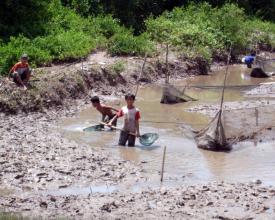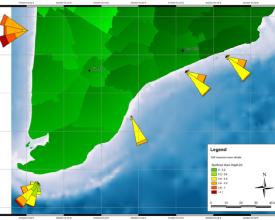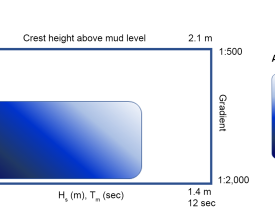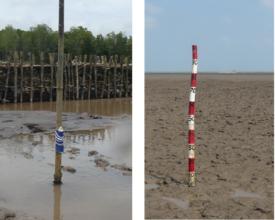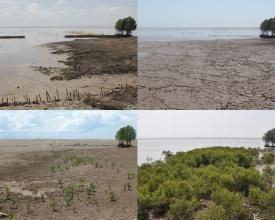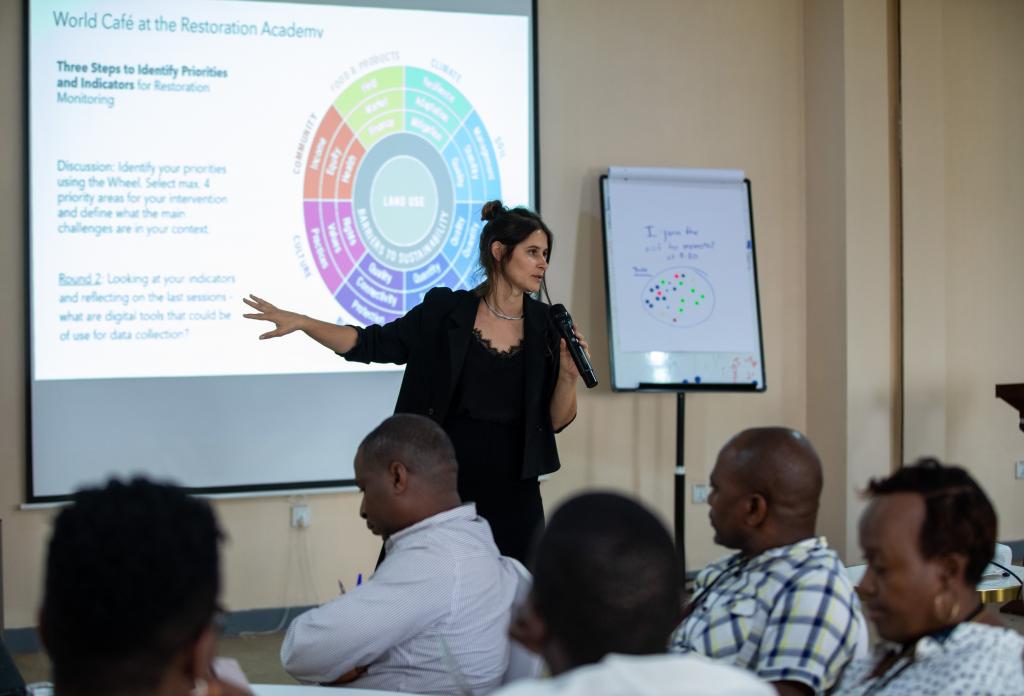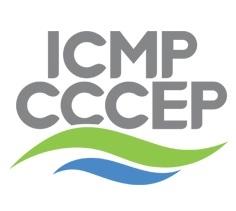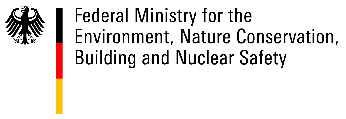
Protección costera basada en los ecosistemas mediante la restauración de llanuras aluviales

La solución proporciona protección a las costas fangosas y a las personas que viven cerca de la costa frente a las inundaciones, las mareas tormentosas y la erosión. Esto se consigue restaurando las llanuras aluviales erosionadas como condición previa para la regeneración natural o la rehabilitación de los bosques de manglares como elementos de un enfoque basado en el ecosistema para la protección costera de la zona. Las vallas de bambú permeables en forma de T rellenas de haces de broza blanda son eficaces para restaurar las llanuras aluviales erosionadas. Esta solución sólo funciona dentro de un conjunto específico de condiciones límite y debe ser específica para cada lugar y apropiada. Desarrollada para la costa fangosa del bajo delta del Mekong, en Vietnam, proporciona seguridad a las personas que viven directamente detrás de los diques.
Contexto
Défis à relever
A lo largo de las costas de barro de los manglares del delta del Mekong, la erosión, las inundaciones y las tormentas afectan a los medios de subsistencia y la vida de miles de personas, a menudo agricultores y pescadores pobres. Una vez degradados o destruidos los manglares, que protegen la costa, las olas erosionarán las llanuras aluviales y luego las olas empezarán a erosionar el dique de tierra. Esto conducirá al desbordamiento del dique y, finalmente, a su destrucción. Soluciones como reforzar el dique con sacos de arena o gaviones son sólo medidas temporales que no abordan la causa de fondo: una llanura de inundación baja debido a la erosión. Por lo tanto, se necesita una solución que aborde la causa de raíz.
Ubicación
Procesar
Resumen del proceso
Los componentes básicos se complementan entre sí para lograr una solución sólida que restaure de forma sostenible las llanuras aluviales y rehabilite los manglares y sus servicios ecosistémicos. La "Modelización numérica de la hidrodinámica y la sedimentodinámica" (módulo 1) proporciona una base sólida para comprender plenamente la dinámica local de la zona, así como importantes condiciones de contorno para el diseño y la construcción de los rompeolas. Es el prerrequisito necesario para el building block 2, la "Planificación, diseño y construcción de rompeolas apropiados", que incluye la selección de los emplazamientos adecuados para la construcción de las vallas en "T". De este modo, los dos primeros elementos contribuyen a la acumulación de sedimentos y a la regeneración natural de los manglares. El elemento 3, "Vigilancia y mantenimiento de los rompeolas", garantiza el buen funcionamiento de la propia infraestructura, y el elemento 4, "Protección y plantación de manglares", completa la solución protegiendo la regeneración natural de los manglares y, en caso necesario, plantando especies adecuadas. La concienciación y la implicación de todas las partes interesadas no sólo son cruciales para el éxito de cada componente, sino también para la sostenibilidad a largo plazo de la solución.
Bloques de construcción
Modelización numérica de la hidrodinámica y la sedimentación
Esta herramienta sirve para comprender y proyectar las fuerzas naturales que están dando forma a la costa con el fin de planificar la ubicación y el diseño óptimos de los espigones: Utilizar los datos disponibles y de campo (para todas las estaciones) sobre batimetría cercana a la costa (perfiles de profundidad), altura, dirección y periodo de las olas; régimen de mareas y corrientes; composición de los sedimentos (del fondo marino y en suspensión), y patrones de viento, para calibrar y validar los modelos numéricos. Elaborar mapas sobre el clima de olas, el régimen de mareas, el transporte de sedimentos y la batimetría. Utilizar las condiciones hidrodinámicas y sedimentarias previstas para determinar la viabilidad, el mejor diseño y la ubicación de los rompeolas.
Factores facilitadores
- Costas dominadas por sedimentos fangosos (arena fina, limo, arcilla).
- Cerca de la costa relativamente poco profunda con poca pendiente en el perfil batimétrico.
- Suficiente aporte de sedimentos en suspensión.
- Posibilidad de utilizar vallas en T para recrear la línea costera original entre los cabos existentes con cobertura de manglares.
- Registros históricos de la presencia de manglares en el sitio para evaluar la viabilidad de la regeneración natural de los manglares o la rehabilitación de los manglares.
Lección aprendida
Los conocimientos de ingeniería costera, los programas informáticos especializados y la facilitación resultaron ser obligatorios. La implicación de los departamentos técnicos locales y las autoridades responsables, así como una información adecuada, son necesarias para garantizar el compromiso y el apoyo a largo plazo. Debe tenerse en cuenta la priorización de los lugares por parte de las autoridades locales, o debido a los valores socioeconómicos relacionados con el uso del interior. Las autoridades competentes y los socios deben ser conscientes de que los resultados de la modelización numérica pueden resultar valiosos para otras medidas previstas en la zona. Esto puede aumentar la eficacia y crear sinergias valiosas.
Planificación y construcción de rompeolas
Los modelos físicos determinan el diseño óptimo de los espigones reales. La resistencia de las varas de bambú se comprobó durante las pruebas de campo de las vallas. La información sobre la durabilidad del bambú procede de experiencias con bambú en Tailandia. La población local es informada de la actividad prevista y participa en ella. Con apoyo técnico, la población local construye rompeolas, es decir, vallas en forma de T con materiales naturales (bambú). Las vallas en T permeables no impiden la entrada de sedimentos y crean condiciones de aguas tranquilas para la deposición de sedimentos. Las partes longitudinales rompen las olas y las transversales recogen los sedimentos suspendidos en las corrientes litorales. Los huecos en las partes de la orilla larga mejoran la entrada de sedimentos en los campos creados por las vallas durante la marea alta, mientras que el drenaje se acelera a través de las aberturas durante la marea baja, acelerando así el proceso de consolidación del suelo en los campos.
Factores facilitadores
El éxito del diseño y la construcción depende de los resultados de la modelización numérica, las observaciones de los cambios en la línea de costa, los registros de erosión y la buena ejecución de la construcción de la valla en T y la supervisión de la obra.
Para que las vallas sean eficaces, deben cumplirse las siguientes condiciones límite
- Entorno fangoso; tamaño de grano medio diámetro de la capa superior del lodo d50 < 0,03 mm
- Altura de ola significativa Hs < 0,90 m
- Periodo medio de las olas Tm < 8 s
- Pendiente pequeña de la llanura de marea < 1:1000
- Altura libre de la cresta de la construcción < 1,40 m
Lección aprendida
La participación de los departamentos técnicos, las autoridades locales y la población en el proceso de planificación, diseño y construcción fue importante para garantizar la aceptación, el apoyo, el compromiso a largo plazo y la apropiación. La forma más eficaz de restaurar las costas erosionadas es utilizar vallas en T permeables que creen condiciones de aguas tranquilas para la deposición de sedimentos y reduzcan la erosión. La construcción de las vallas en T debe seguir normas de calidad y estar bien supervisada. Este enfoque rentable sólo será viable dentro de un conjunto específico de condiciones límite (véase el gráfico siguiente). Si estos criterios limitadores sólo se superan en pequeña medida, habrá que considerar adaptaciones como el refuerzo de la valla con postes de hormigón. Si los criterios limitadores se superan en gran medida, el uso de vallas en T no es viable. Otros factores a tener en cuenta son la ubicación de las vallas para minimizar la erosión de sotavento, así como la proximidad a la costa y la duración de los periodos de inmersión para minimizar los daños causados por los gusanos de barco. La duración de la inmersión y la exposición a las olas también afectan al esfuerzo necesario para el mantenimiento.
Supervisión y mantenimiento del rompeolas
Se utiliza un sistema de vigilancia para medir la acumulación de sedimentos y controlar el estado de las vallas en T. Además, se vigila la regeneración natural de los manglares. Además, se supervisa la regeneración natural de los manglares. Durante el primer año tras la construcción, debe garantizarse la funcionalidad de las vallas en T mediante inspecciones visuales mensuales y mantenimiento cuando sea necesario. Después de un año, las inspecciones visuales y el mantenimiento deben realizarse al menos al final de cada temporada de tormentas. Además, se pueden realizar estudios estacionales con GPS de la línea de costa durante la marea baja para comprobar si las vallas en T influyen en la forma de la línea de costa cercana. La regeneración natural de los manglares se documenta registrando las especies, el tamaño y la densidad o mediante fotografías de punto fijo. Estas últimas también pueden utilizarse como alternativa sencilla a los estudios de la línea de costa con GPS.
Factores facilitadores
- Conocimientos técnicos y mano de obra para encuestas periódicas (recopilación de datos para el seguimiento) e inspecciones visuales rutinarias de la construcción.
- Postes de referencia para registrar la acumulación vertical en varios transectos.
- Las fotografías de puntos fijos son una herramienta fácil de utilizar para supervisar la regeneración de los manglares y los cambios en la línea de costa.
- Mediciones de la consolidación de los sedimentos (densidad del lodo).
- Equipo de medición GPS y conocimientos técnicos para la vigilancia a largo plazo.
Lección aprendida
Para medir el éxito a largo plazo de las vallas en T es crucial disponer de un sistema de seguimiento normalizado del estado de los rompeolas, la acumulación de sedimentos y la regeneración natural de los manglares. La necesidad de trabajos de mantenimiento y reparación puede variar considerablemente de un lugar a otro. La vigilancia a largo plazo basada en estudios con GPS debe incluir las zonas vecinas para descubrir posibles efectos secundarios negativos de las vallas en T (erosión por deriva descendente). Es importante tener en cuenta que, una vez restauradas las llanuras aluviales y establecida una cubierta de manglares adecuada, deben aplicarse medidas de protección de los manglares para garantizar la sostenibilidad de la protección costera. Una vez que el bosque de manglares esté completamente establecido, ya no será necesaria la construcción del rompeolas. Este proceso puede durar varios años.
Protección y plantación de manglares
Las vallas en "T" de bambú se utilizan para restaurar las llanuras aluviales erosionadas y el equilibrio de sedimentos finos como condición previa para la regeneración natural de los bosques de manglares - estos últimos formarán entonces parte de una estrategia eficaz de protección costera de la zona. Una vez restaurados con éxito los lugares aptos para el crecimiento de los manglares, se producirá su regeneración natural. Sin embargo, es esencial que los manglares estén protegidos de los impactos humanos, ya que de lo contrario el ciclo de degradación/destrucción y costosa restauración continuará ininterrumpidamente (véase la ilustración del apartado "¿Cómo interactúan los componentes básicos en la solución?"). La mejor manera de conseguirlo es implicar a la población local en la protección y gestión eficaces de los manglares mediante la cogestión. Para más información, véase la solución "Cogestión (gobernanza compartida) de los recursos naturales en la zona costera". Si los índices de regeneración natural son insuficientes, puede ser necesaria una plantación suplementaria de manglares. En tales casos, es necesario plantar las especies apropiadas en los lugares adecuados y en el momento oportuno.
Factores facilitadores
- Los responsables de la toma de decisiones comprenden los procesos costeros y la ecología de los manglares. - Todas las partes interesadas están dispuestas a participar en la gobernanza compartida (cogestión) de los manglares.
Lección aprendida
La cogestión, o gobernanza compartida, es un enfoque para la protección y gestión sostenible y eficaz de los manglares. También proporciona medios de vida a la población local y contribuye a una mejor gobernanza de los recursos naturales. Los resultados del seguimiento fotográfico de punto fijo de la costa de la provincia de Soc Trang (Vietnam) desde noviembre de 2012 hasta enero de 2015 muestran claramente los impactos de las vallas en T en la sedimentación y, como consecuencia, en la regeneración natural de los manglares. Los silvicultores de manglares necesitan una comprensión sólida de la ecología de los manglares y de los procesos costeros y morfodinámicos. La forma más eficaz de plantar manglares es aprender de la naturaleza, es decir, imitar cómo planta la naturaleza, qué especies planta y cómo crea una zonación de especies. Esta zonificación conduce a una protección costera optimizada mediante la atenuación de las olas por las estructuras radiculares por encima del suelo, junto con la estabilización del suelo por las estructuras radiculares por debajo del suelo (véase la ilustración en "¿Cómo interactúan los bloques de construcción en la solución?").
Impactos
Técnicamente, la solución es eficaz para la protección contra las inundaciones, las mareas de tempestad y la erosión, y para aumentar la biodiversidad y la disponibilidad de servicios ecosistémicos mediante la restauración de las llanuras aluviales como condición previa para la rehabilitación de los manglares en los lugares donde las llanuras aluviales han sido erosionadas. Los manglares sirven de vivero, alimento y refugio a muchas especies acuáticas. Son altamente productivos y hasta el 80% de las capturas pesqueras cercanas a la costa en todo el mundo dependen directa o indirectamente de los manglares. Se calcula que el valor de los manglares oscila entre los 2.000 y los 9.990 dólares anuales por hectárea, por lo que figuran entre los ecosistemas de mayor valor económico. Los manglares retienen hasta 5 veces más carbono que las selvas tropicales. Desde el punto de vista económico, los costes directos de mantenimiento y reparación de los diques se redujeron drásticamente. Las repercusiones socioeconómicas son la seguridad para las personas que viven directamente detrás del dique, la garantía de sus medios de subsistencia gracias a la mejora de la pesca y la acuicultura a pequeña escala.
Beneficiarios
Las personas que viven detrás de diques y en zonas inundables, pescadores y acuicultores.
Historia
La Sra. Sà Vọng vive cerca de Nopol, en la costa de la provincia de Soc Trang, desde que tiene uso de razón. Su familia vivía bien recogiendo leña, pescando, recolectando almejas y berberechos en el manglar y en las marismas para complementar los ingresos de su pequeño estanque piscícola. Mucha gente utilizaba la carretera que pasa junto a su casa para acceder al manglar más allá del dique de tierra que se construyó tras una gran tormenta hace 20 años. Con el tiempo, el pequeño camino que se creó a través de los manglares para acceder a las marismas, con su abundancia de recursos acuáticos como alevines de gobio, berberechos y cangrejos juveniles, se ensanchó y pudo ser utilizado por pequeñas embarcaciones de pesca. Este desarrollo provocó la erosión. Con el tiempo destruyó un tramo de 100 m de manglar frente al dique. Como consecuencia, la Sra. Sà Vọng vio que durante la temporada de tormentas y mareas altas las olas a menudo sobrepasaban el dique y el agua salada inundaba su pequeño huerto y su casa. Cuando el dique amenazó con romperse, las autoridades locales gastaron mucho dinero en elevar su altura y reforzar su frente con gaviones y postes de Melaleuca. Después de la mayoría de las mareas altas de primavera, el dique tuvo que ser reparado de nuevo, como se muestra en la foto de Vinh Tan (cerca de Nopol). Se pidió al proyecto de la GIZ "Gestión de los recursos naturales de la zona costera de la provincia de Soc Trang" que ayudara a las autoridades locales a encontrar mejores soluciones. Para garantizar la viabilidad a largo plazo, el proyecto aplicó un enfoque basado en el ecosistema para restaurar las llanuras aluviales erosionadas mediante vallas de bambú en forma de T como condición previa para la posterior regeneración natural de los manglares. En mayo de 2012 comenzó la construcción de las vallas en forma de T. Ya durante las obras, la Sra. Sà Vọng dijo al personal del proyecto que estaba muy contenta porque las olas ya no llegaban al dique y su casa ya no estaba expuesta a inundaciones ni a fuertes vientos. Sólo un año después de la construcción se habían acumulado muchos sedimentos detrás de las vallas en T y habían empezado a consolidarse para permitir la reaparición de los manglares. En un lugar cercano a la valla en T, aparecieron plántulas de Avicennia y crecieron bien sólo 9 meses después de la finalización de las vallas en T. Esto es un claro indicio de que la valla en T ha vuelto a crecer. Este es un claro indicio de que las vallas T han vuelto a crear las condiciones adecuadas para el crecimiento de los manglares.

